TAXATION LAW. Taxation Law Name of the Student Name of
VerifiedAdded on 2023/02/01
|18
|4324
|44
AI Summary
Contribute Materials
Your contribution can guide someone’s learning journey. Share your
documents today.
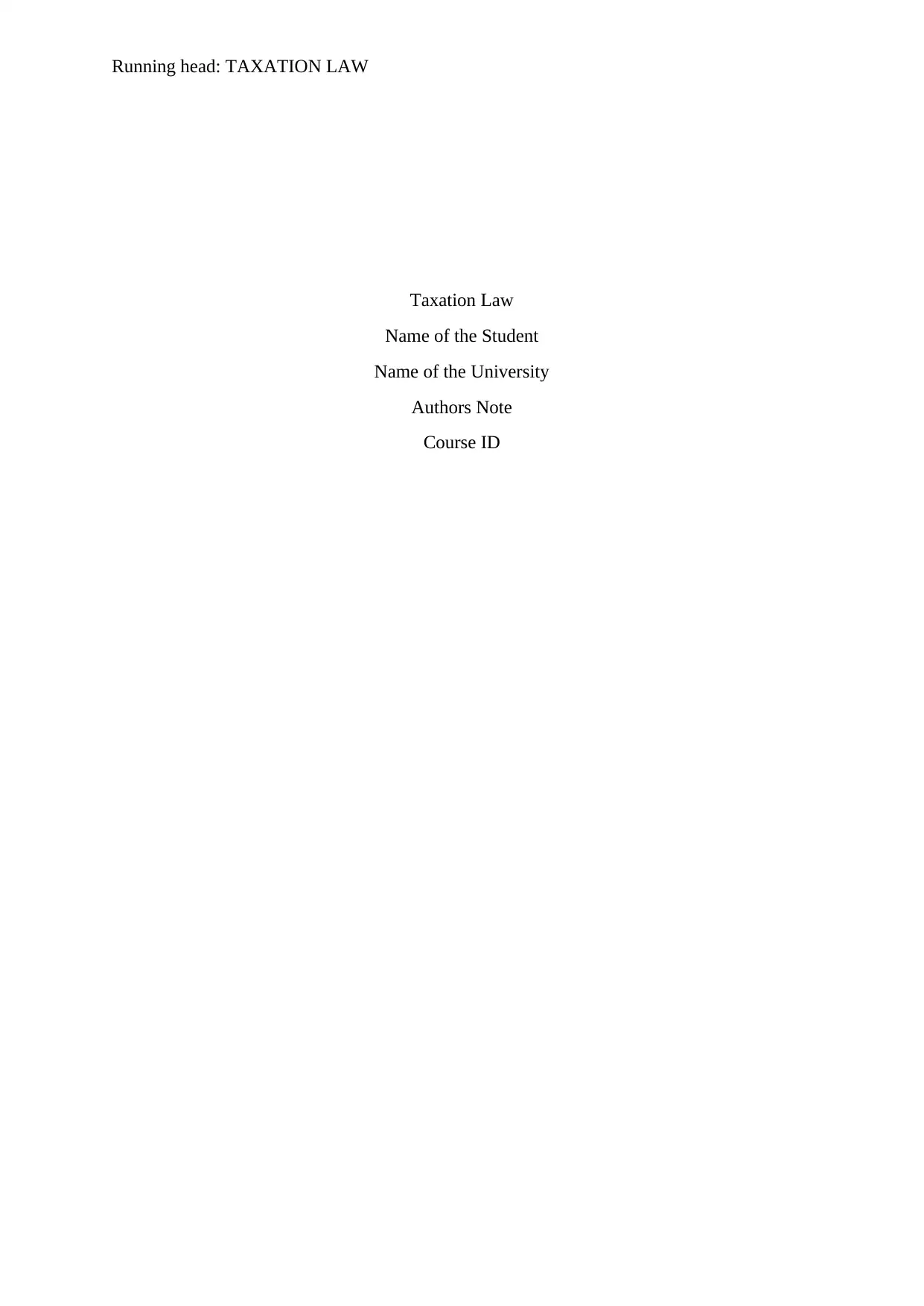
Running head: TAXATION LAW
Taxation Law
Name of the Student
Name of the University
Authors Note
Course ID
Taxation Law
Name of the Student
Name of the University
Authors Note
Course ID
Secure Best Marks with AI Grader
Need help grading? Try our AI Grader for instant feedback on your assignments.
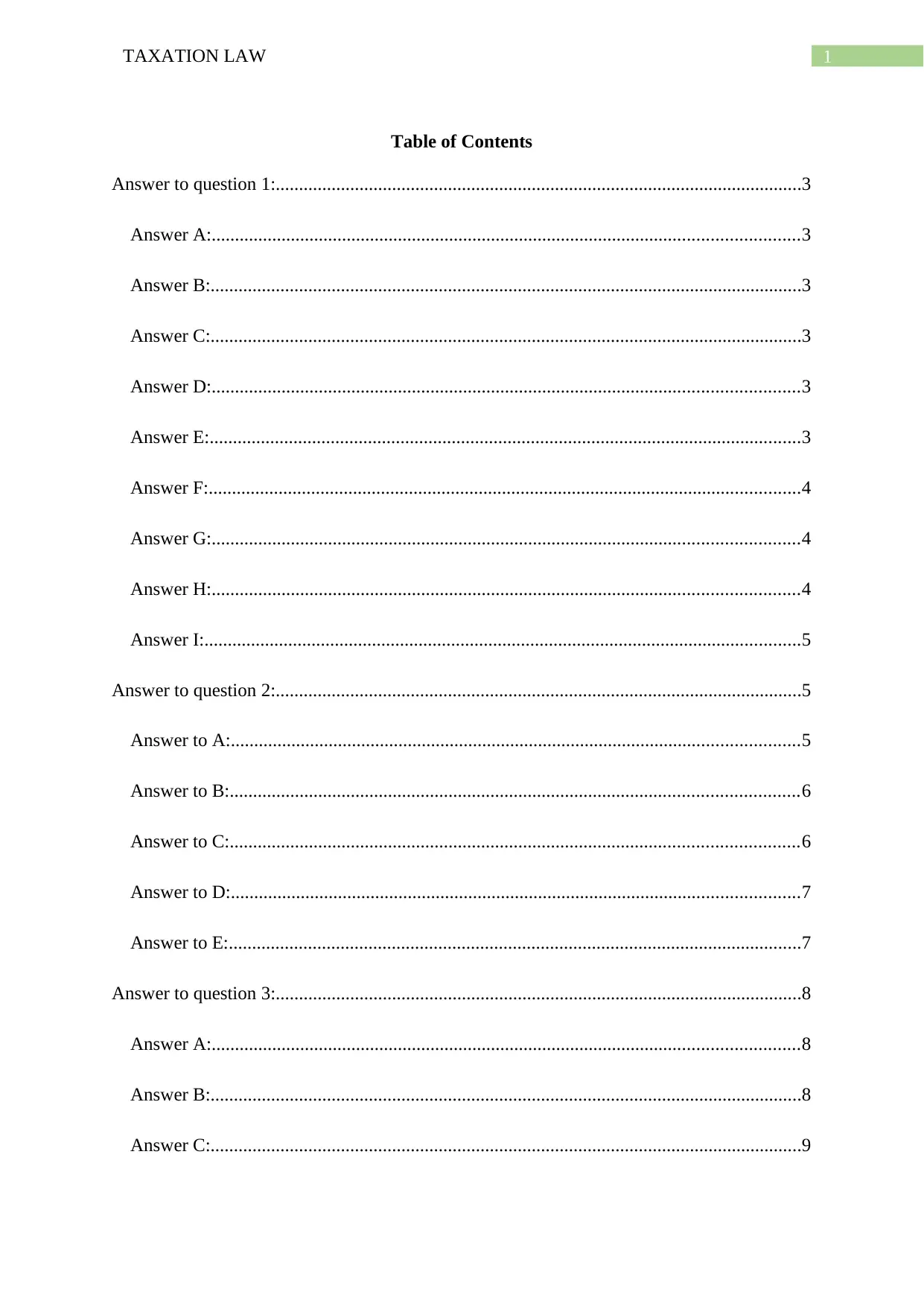
1TAXATION LAW
Table of Contents
Answer to question 1:.................................................................................................................3
Answer A:..............................................................................................................................3
Answer B:...............................................................................................................................3
Answer C:...............................................................................................................................3
Answer D:..............................................................................................................................3
Answer E:...............................................................................................................................3
Answer F:...............................................................................................................................4
Answer G:..............................................................................................................................4
Answer H:..............................................................................................................................4
Answer I:................................................................................................................................5
Answer to question 2:.................................................................................................................5
Answer to A:..........................................................................................................................5
Answer to B:..........................................................................................................................6
Answer to C:..........................................................................................................................6
Answer to D:..........................................................................................................................7
Answer to E:...........................................................................................................................7
Answer to question 3:.................................................................................................................8
Answer A:..............................................................................................................................8
Answer B:...............................................................................................................................8
Answer C:...............................................................................................................................9
Table of Contents
Answer to question 1:.................................................................................................................3
Answer A:..............................................................................................................................3
Answer B:...............................................................................................................................3
Answer C:...............................................................................................................................3
Answer D:..............................................................................................................................3
Answer E:...............................................................................................................................3
Answer F:...............................................................................................................................4
Answer G:..............................................................................................................................4
Answer H:..............................................................................................................................4
Answer I:................................................................................................................................5
Answer to question 2:.................................................................................................................5
Answer to A:..........................................................................................................................5
Answer to B:..........................................................................................................................6
Answer to C:..........................................................................................................................6
Answer to D:..........................................................................................................................7
Answer to E:...........................................................................................................................7
Answer to question 3:.................................................................................................................8
Answer A:..............................................................................................................................8
Answer B:...............................................................................................................................8
Answer C:...............................................................................................................................9
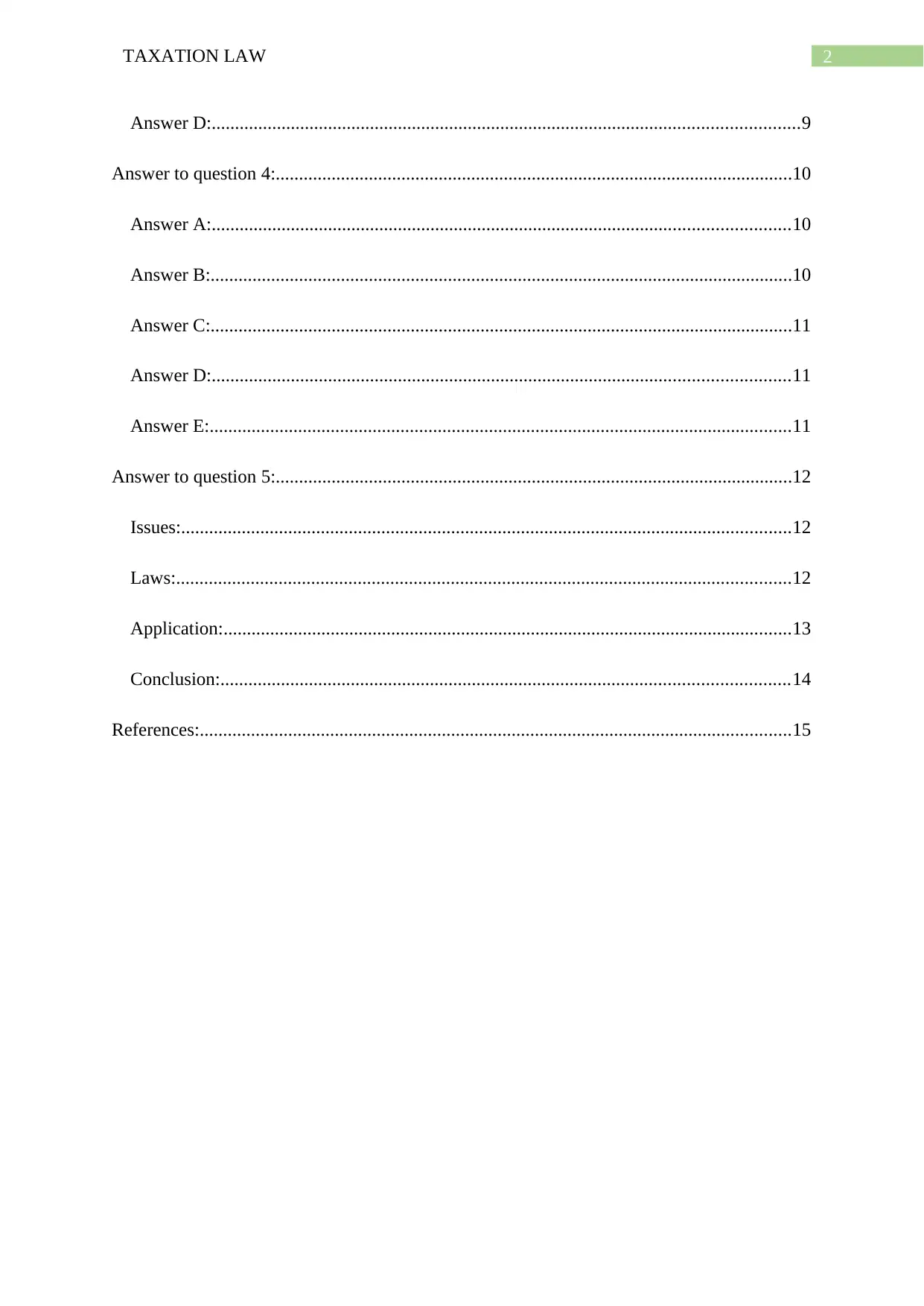
2TAXATION LAW
Answer D:..............................................................................................................................9
Answer to question 4:...............................................................................................................10
Answer A:............................................................................................................................10
Answer B:.............................................................................................................................10
Answer C:.............................................................................................................................11
Answer D:............................................................................................................................11
Answer E:.............................................................................................................................11
Answer to question 5:...............................................................................................................12
Issues:...................................................................................................................................12
Laws:....................................................................................................................................12
Application:..........................................................................................................................13
Conclusion:..........................................................................................................................14
References:...............................................................................................................................15
Answer D:..............................................................................................................................9
Answer to question 4:...............................................................................................................10
Answer A:............................................................................................................................10
Answer B:.............................................................................................................................10
Answer C:.............................................................................................................................11
Answer D:............................................................................................................................11
Answer E:.............................................................................................................................11
Answer to question 5:...............................................................................................................12
Issues:...................................................................................................................................12
Laws:....................................................................................................................................12
Application:..........................................................................................................................13
Conclusion:..........................................................................................................................14
References:...............................................................................................................................15
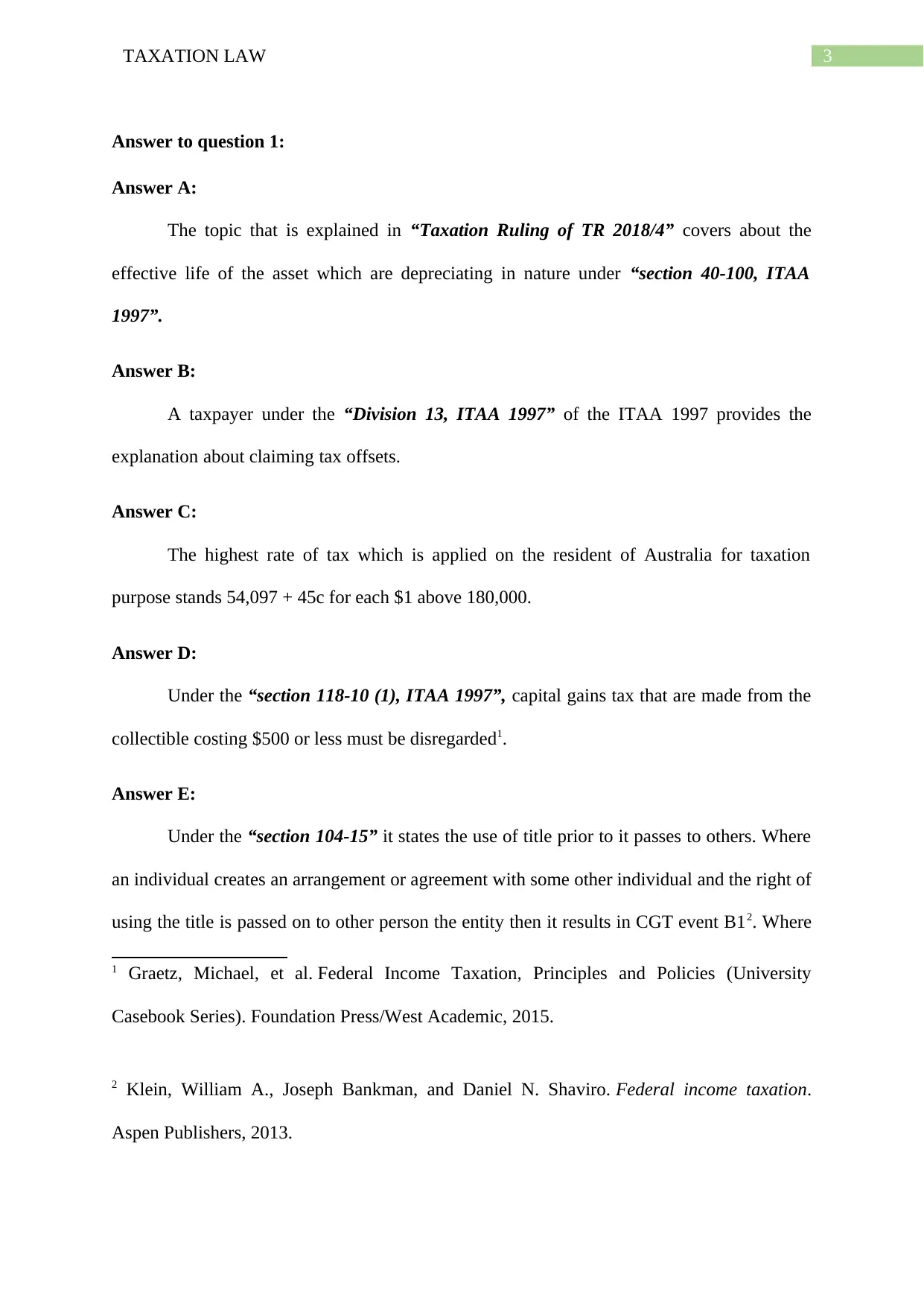
3TAXATION LAW
Answer to question 1:
Answer A:
The topic that is explained in “Taxation Ruling of TR 2018/4” covers about the
effective life of the asset which are depreciating in nature under “section 40-100, ITAA
1997”.
Answer B:
A taxpayer under the “Division 13, ITAA 1997” of the ITAA 1997 provides the
explanation about claiming tax offsets.
Answer C:
The highest rate of tax which is applied on the resident of Australia for taxation
purpose stands 54,097 + 45c for each $1 above 180,000.
Answer D:
Under the “section 118-10 (1), ITAA 1997”, capital gains tax that are made from the
collectible costing $500 or less must be disregarded1.
Answer E:
Under the “section 104-15” it states the use of title prior to it passes to others. Where
an individual creates an arrangement or agreement with some other individual and the right of
using the title is passed on to other person the entity then it results in CGT event B12. Where
1 Graetz, Michael, et al. Federal Income Taxation, Principles and Policies (University
Casebook Series). Foundation Press/West Academic, 2015.
2 Klein, William A., Joseph Bankman, and Daniel N. Shaviro. Federal income taxation.
Aspen Publishers, 2013.
Answer to question 1:
Answer A:
The topic that is explained in “Taxation Ruling of TR 2018/4” covers about the
effective life of the asset which are depreciating in nature under “section 40-100, ITAA
1997”.
Answer B:
A taxpayer under the “Division 13, ITAA 1997” of the ITAA 1997 provides the
explanation about claiming tax offsets.
Answer C:
The highest rate of tax which is applied on the resident of Australia for taxation
purpose stands 54,097 + 45c for each $1 above 180,000.
Answer D:
Under the “section 118-10 (1), ITAA 1997”, capital gains tax that are made from the
collectible costing $500 or less must be disregarded1.
Answer E:
Under the “section 104-15” it states the use of title prior to it passes to others. Where
an individual creates an arrangement or agreement with some other individual and the right of
using the title is passed on to other person the entity then it results in CGT event B12. Where
1 Graetz, Michael, et al. Federal Income Taxation, Principles and Policies (University
Casebook Series). Foundation Press/West Academic, 2015.
2 Klein, William A., Joseph Bankman, and Daniel N. Shaviro. Federal income taxation.
Aspen Publishers, 2013.
Secure Best Marks with AI Grader
Need help grading? Try our AI Grader for instant feedback on your assignments.
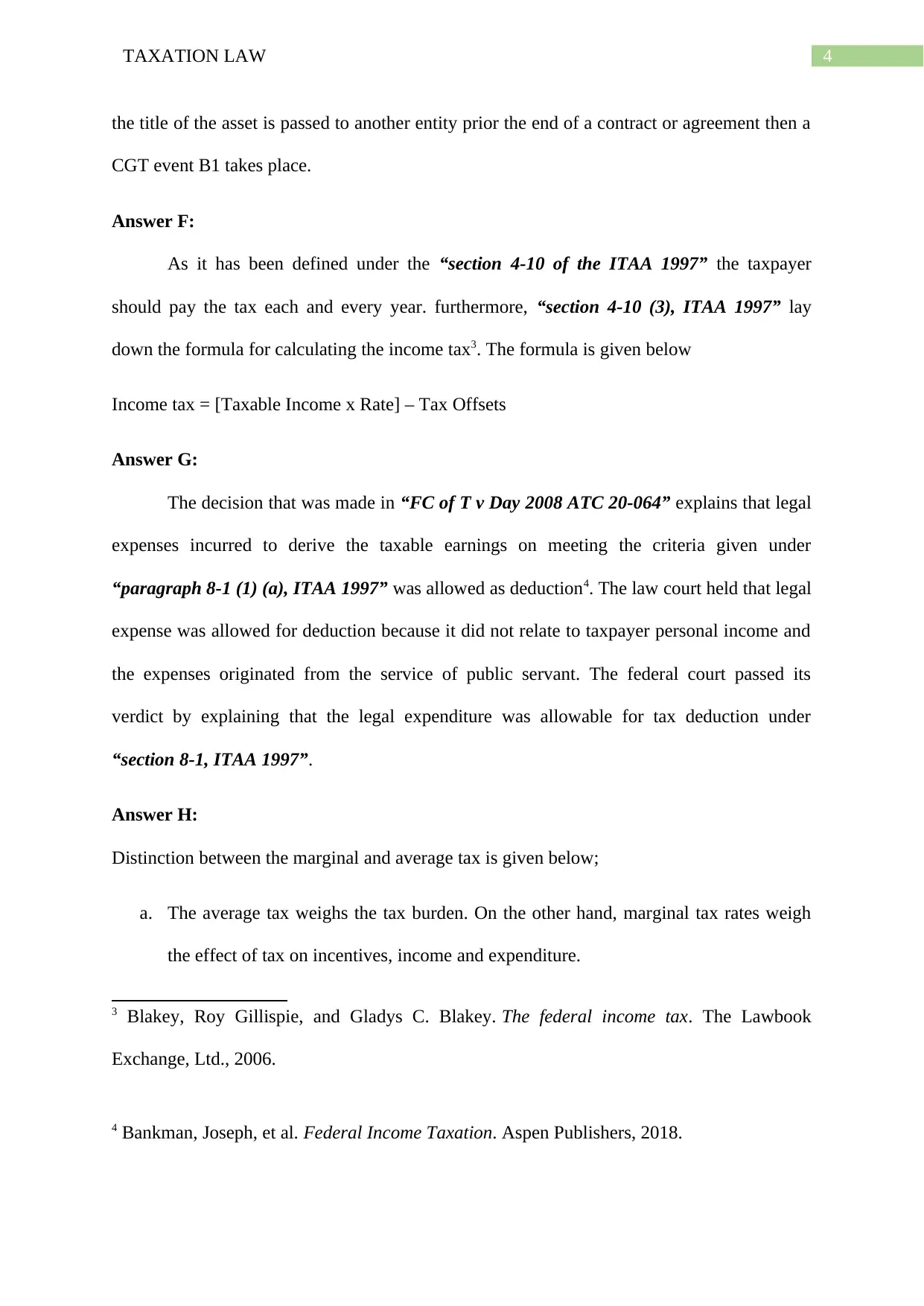
4TAXATION LAW
the title of the asset is passed to another entity prior the end of a contract or agreement then a
CGT event B1 takes place.
Answer F:
As it has been defined under the “section 4-10 of the ITAA 1997” the taxpayer
should pay the tax each and every year. furthermore, “section 4-10 (3), ITAA 1997” lay
down the formula for calculating the income tax3. The formula is given below
Income tax = [Taxable Income x Rate] – Tax Offsets
Answer G:
The decision that was made in “FC of T v Day 2008 ATC 20-064” explains that legal
expenses incurred to derive the taxable earnings on meeting the criteria given under
“paragraph 8-1 (1) (a), ITAA 1997” was allowed as deduction4. The law court held that legal
expense was allowed for deduction because it did not relate to taxpayer personal income and
the expenses originated from the service of public servant. The federal court passed its
verdict by explaining that the legal expenditure was allowable for tax deduction under
“section 8-1, ITAA 1997”.
Answer H:
Distinction between the marginal and average tax is given below;
a. The average tax weighs the tax burden. On the other hand, marginal tax rates weigh
the effect of tax on incentives, income and expenditure.
3 Blakey, Roy Gillispie, and Gladys C. Blakey. The federal income tax. The Lawbook
Exchange, Ltd., 2006.
4 Bankman, Joseph, et al. Federal Income Taxation. Aspen Publishers, 2018.
the title of the asset is passed to another entity prior the end of a contract or agreement then a
CGT event B1 takes place.
Answer F:
As it has been defined under the “section 4-10 of the ITAA 1997” the taxpayer
should pay the tax each and every year. furthermore, “section 4-10 (3), ITAA 1997” lay
down the formula for calculating the income tax3. The formula is given below
Income tax = [Taxable Income x Rate] – Tax Offsets
Answer G:
The decision that was made in “FC of T v Day 2008 ATC 20-064” explains that legal
expenses incurred to derive the taxable earnings on meeting the criteria given under
“paragraph 8-1 (1) (a), ITAA 1997” was allowed as deduction4. The law court held that legal
expense was allowed for deduction because it did not relate to taxpayer personal income and
the expenses originated from the service of public servant. The federal court passed its
verdict by explaining that the legal expenditure was allowable for tax deduction under
“section 8-1, ITAA 1997”.
Answer H:
Distinction between the marginal and average tax is given below;
a. The average tax weighs the tax burden. On the other hand, marginal tax rates weigh
the effect of tax on incentives, income and expenditure.
3 Blakey, Roy Gillispie, and Gladys C. Blakey. The federal income tax. The Lawbook
Exchange, Ltd., 2006.
4 Bankman, Joseph, et al. Federal Income Taxation. Aspen Publishers, 2018.
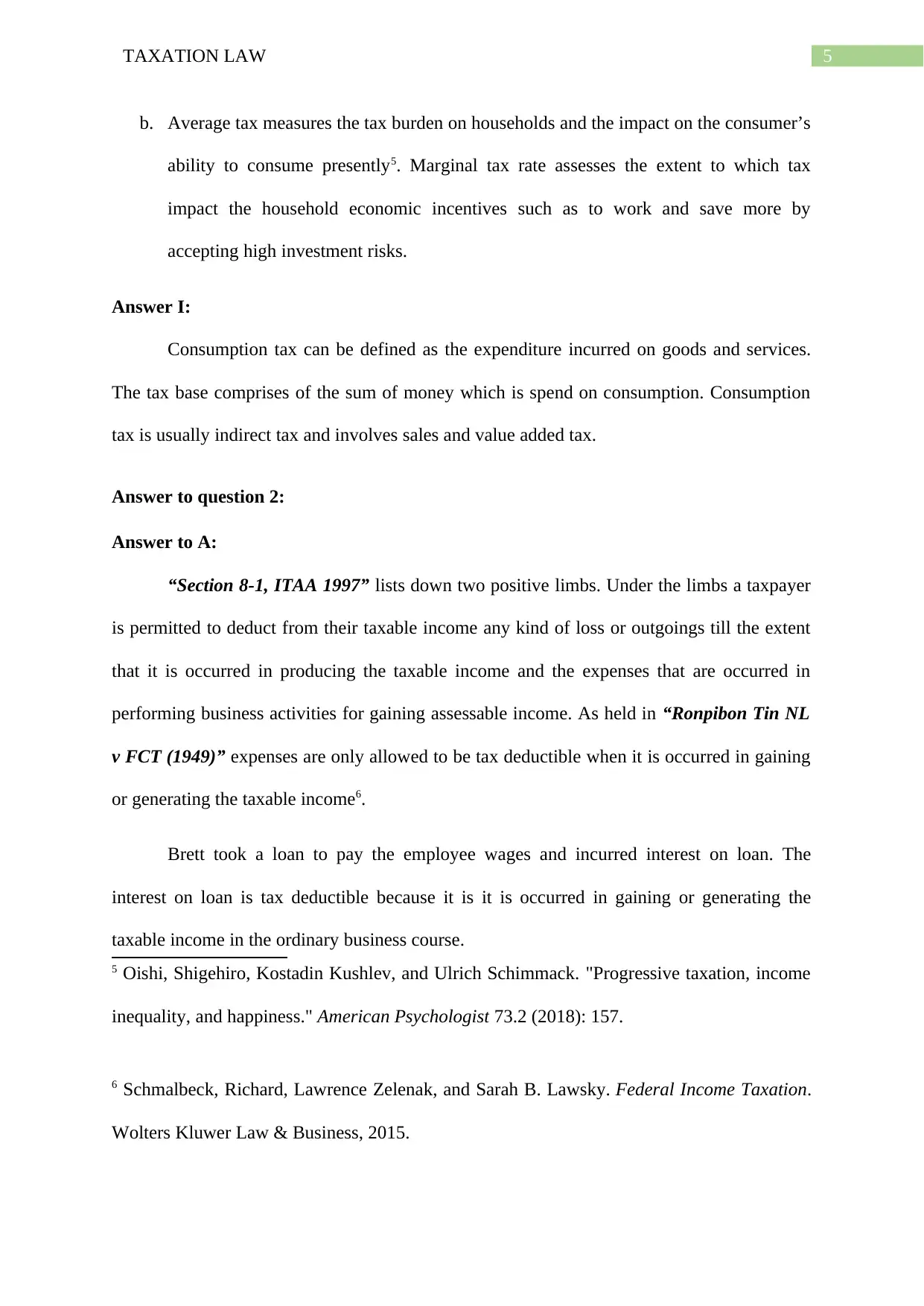
5TAXATION LAW
b. Average tax measures the tax burden on households and the impact on the consumer’s
ability to consume presently5. Marginal tax rate assesses the extent to which tax
impact the household economic incentives such as to work and save more by
accepting high investment risks.
Answer I:
Consumption tax can be defined as the expenditure incurred on goods and services.
The tax base comprises of the sum of money which is spend on consumption. Consumption
tax is usually indirect tax and involves sales and value added tax.
Answer to question 2:
Answer to A:
“Section 8-1, ITAA 1997” lists down two positive limbs. Under the limbs a taxpayer
is permitted to deduct from their taxable income any kind of loss or outgoings till the extent
that it is occurred in producing the taxable income and the expenses that are occurred in
performing business activities for gaining assessable income. As held in “Ronpibon Tin NL
v FCT (1949)” expenses are only allowed to be tax deductible when it is occurred in gaining
or generating the taxable income6.
Brett took a loan to pay the employee wages and incurred interest on loan. The
interest on loan is tax deductible because it is it is occurred in gaining or generating the
taxable income in the ordinary business course.
5 Oishi, Shigehiro, Kostadin Kushlev, and Ulrich Schimmack. "Progressive taxation, income
inequality, and happiness." American Psychologist 73.2 (2018): 157.
6 Schmalbeck, Richard, Lawrence Zelenak, and Sarah B. Lawsky. Federal Income Taxation.
Wolters Kluwer Law & Business, 2015.
b. Average tax measures the tax burden on households and the impact on the consumer’s
ability to consume presently5. Marginal tax rate assesses the extent to which tax
impact the household economic incentives such as to work and save more by
accepting high investment risks.
Answer I:
Consumption tax can be defined as the expenditure incurred on goods and services.
The tax base comprises of the sum of money which is spend on consumption. Consumption
tax is usually indirect tax and involves sales and value added tax.
Answer to question 2:
Answer to A:
“Section 8-1, ITAA 1997” lists down two positive limbs. Under the limbs a taxpayer
is permitted to deduct from their taxable income any kind of loss or outgoings till the extent
that it is occurred in producing the taxable income and the expenses that are occurred in
performing business activities for gaining assessable income. As held in “Ronpibon Tin NL
v FCT (1949)” expenses are only allowed to be tax deductible when it is occurred in gaining
or generating the taxable income6.
Brett took a loan to pay the employee wages and incurred interest on loan. The
interest on loan is tax deductible because it is it is occurred in gaining or generating the
taxable income in the ordinary business course.
5 Oishi, Shigehiro, Kostadin Kushlev, and Ulrich Schimmack. "Progressive taxation, income
inequality, and happiness." American Psychologist 73.2 (2018): 157.
6 Schmalbeck, Richard, Lawrence Zelenak, and Sarah B. Lawsky. Federal Income Taxation.
Wolters Kluwer Law & Business, 2015.
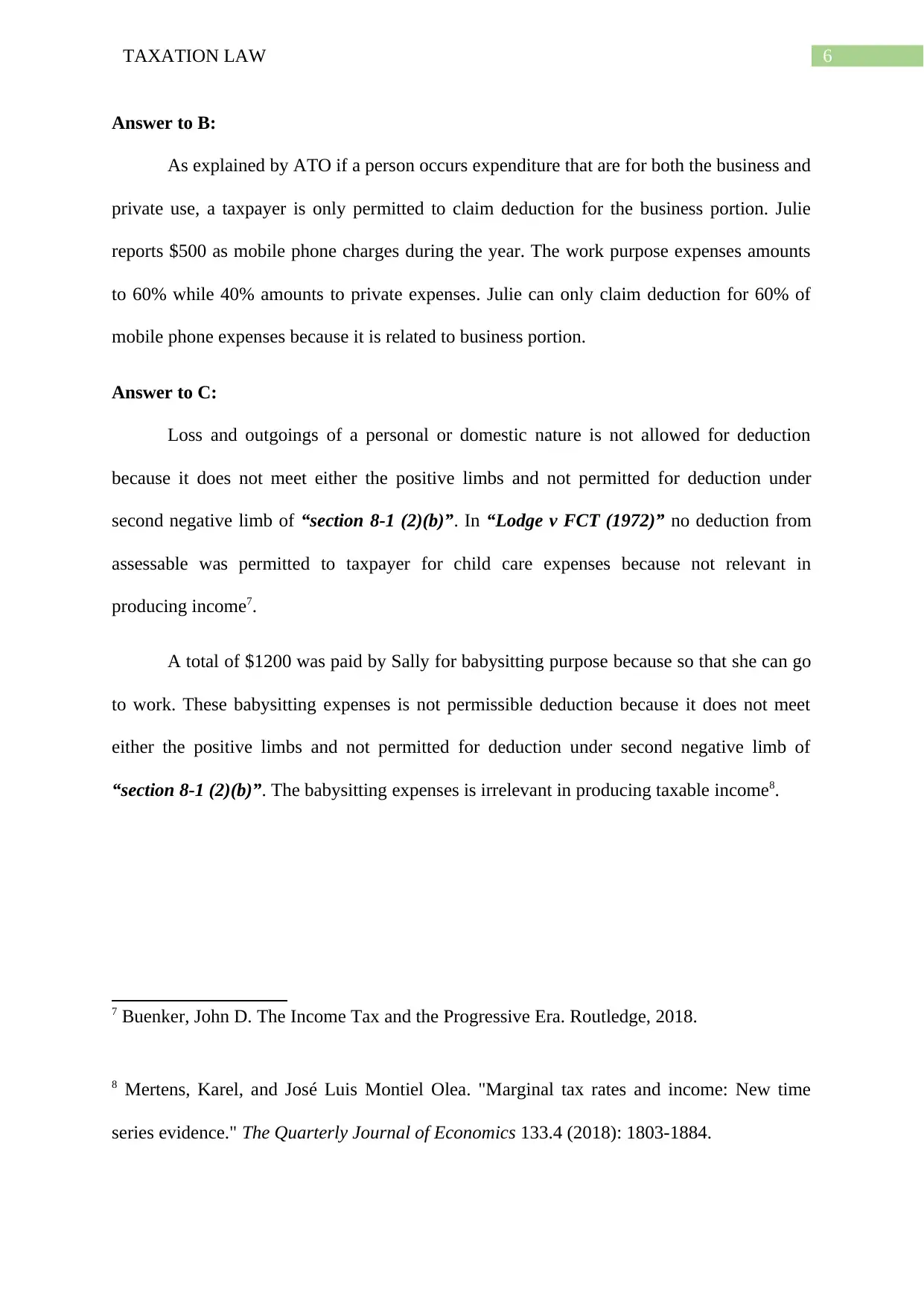
6TAXATION LAW
Answer to B:
As explained by ATO if a person occurs expenditure that are for both the business and
private use, a taxpayer is only permitted to claim deduction for the business portion. Julie
reports $500 as mobile phone charges during the year. The work purpose expenses amounts
to 60% while 40% amounts to private expenses. Julie can only claim deduction for 60% of
mobile phone expenses because it is related to business portion.
Answer to C:
Loss and outgoings of a personal or domestic nature is not allowed for deduction
because it does not meet either the positive limbs and not permitted for deduction under
second negative limb of “section 8-1 (2)(b)”. In “Lodge v FCT (1972)” no deduction from
assessable was permitted to taxpayer for child care expenses because not relevant in
producing income7.
A total of $1200 was paid by Sally for babysitting purpose because so that she can go
to work. These babysitting expenses is not permissible deduction because it does not meet
either the positive limbs and not permitted for deduction under second negative limb of
“section 8-1 (2)(b)”. The babysitting expenses is irrelevant in producing taxable income8.
7 Buenker, John D. The Income Tax and the Progressive Era. Routledge, 2018.
8 Mertens, Karel, and José Luis Montiel Olea. "Marginal tax rates and income: New time
series evidence." The Quarterly Journal of Economics 133.4 (2018): 1803-1884.
Answer to B:
As explained by ATO if a person occurs expenditure that are for both the business and
private use, a taxpayer is only permitted to claim deduction for the business portion. Julie
reports $500 as mobile phone charges during the year. The work purpose expenses amounts
to 60% while 40% amounts to private expenses. Julie can only claim deduction for 60% of
mobile phone expenses because it is related to business portion.
Answer to C:
Loss and outgoings of a personal or domestic nature is not allowed for deduction
because it does not meet either the positive limbs and not permitted for deduction under
second negative limb of “section 8-1 (2)(b)”. In “Lodge v FCT (1972)” no deduction from
assessable was permitted to taxpayer for child care expenses because not relevant in
producing income7.
A total of $1200 was paid by Sally for babysitting purpose because so that she can go
to work. These babysitting expenses is not permissible deduction because it does not meet
either the positive limbs and not permitted for deduction under second negative limb of
“section 8-1 (2)(b)”. The babysitting expenses is irrelevant in producing taxable income8.
7 Buenker, John D. The Income Tax and the Progressive Era. Routledge, 2018.
8 Mertens, Karel, and José Luis Montiel Olea. "Marginal tax rates and income: New time
series evidence." The Quarterly Journal of Economics 133.4 (2018): 1803-1884.
Paraphrase This Document
Need a fresh take? Get an instant paraphrase of this document with our AI Paraphraser
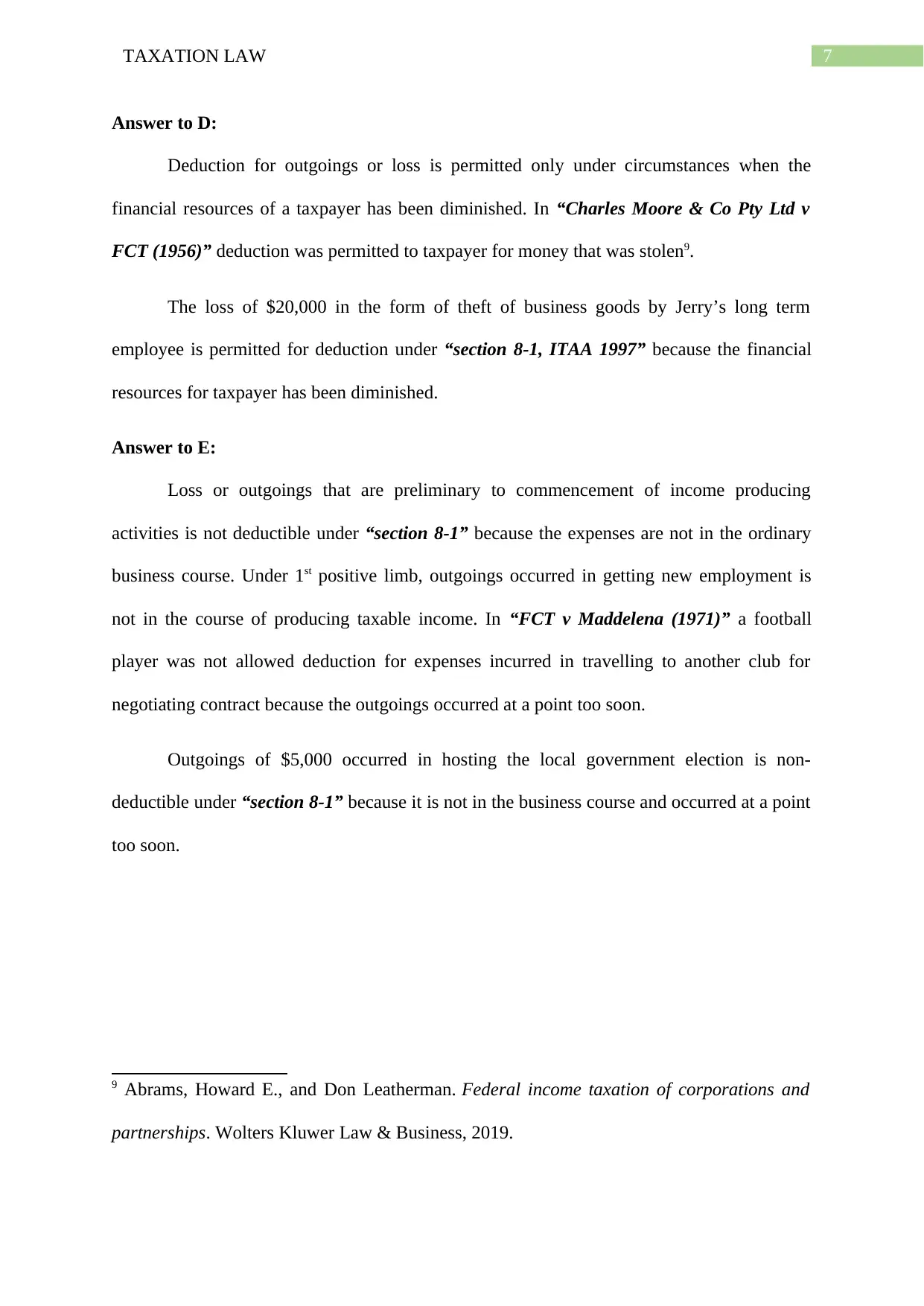
7TAXATION LAW
Answer to D:
Deduction for outgoings or loss is permitted only under circumstances when the
financial resources of a taxpayer has been diminished. In “Charles Moore & Co Pty Ltd v
FCT (1956)” deduction was permitted to taxpayer for money that was stolen9.
The loss of $20,000 in the form of theft of business goods by Jerry’s long term
employee is permitted for deduction under “section 8-1, ITAA 1997” because the financial
resources for taxpayer has been diminished.
Answer to E:
Loss or outgoings that are preliminary to commencement of income producing
activities is not deductible under “section 8-1” because the expenses are not in the ordinary
business course. Under 1st positive limb, outgoings occurred in getting new employment is
not in the course of producing taxable income. In “FCT v Maddelena (1971)” a football
player was not allowed deduction for expenses incurred in travelling to another club for
negotiating contract because the outgoings occurred at a point too soon.
Outgoings of $5,000 occurred in hosting the local government election is non-
deductible under “section 8-1” because it is not in the business course and occurred at a point
too soon.
9 Abrams, Howard E., and Don Leatherman. Federal income taxation of corporations and
partnerships. Wolters Kluwer Law & Business, 2019.
Answer to D:
Deduction for outgoings or loss is permitted only under circumstances when the
financial resources of a taxpayer has been diminished. In “Charles Moore & Co Pty Ltd v
FCT (1956)” deduction was permitted to taxpayer for money that was stolen9.
The loss of $20,000 in the form of theft of business goods by Jerry’s long term
employee is permitted for deduction under “section 8-1, ITAA 1997” because the financial
resources for taxpayer has been diminished.
Answer to E:
Loss or outgoings that are preliminary to commencement of income producing
activities is not deductible under “section 8-1” because the expenses are not in the ordinary
business course. Under 1st positive limb, outgoings occurred in getting new employment is
not in the course of producing taxable income. In “FCT v Maddelena (1971)” a football
player was not allowed deduction for expenses incurred in travelling to another club for
negotiating contract because the outgoings occurred at a point too soon.
Outgoings of $5,000 occurred in hosting the local government election is non-
deductible under “section 8-1” because it is not in the business course and occurred at a point
too soon.
9 Abrams, Howard E., and Don Leatherman. Federal income taxation of corporations and
partnerships. Wolters Kluwer Law & Business, 2019.
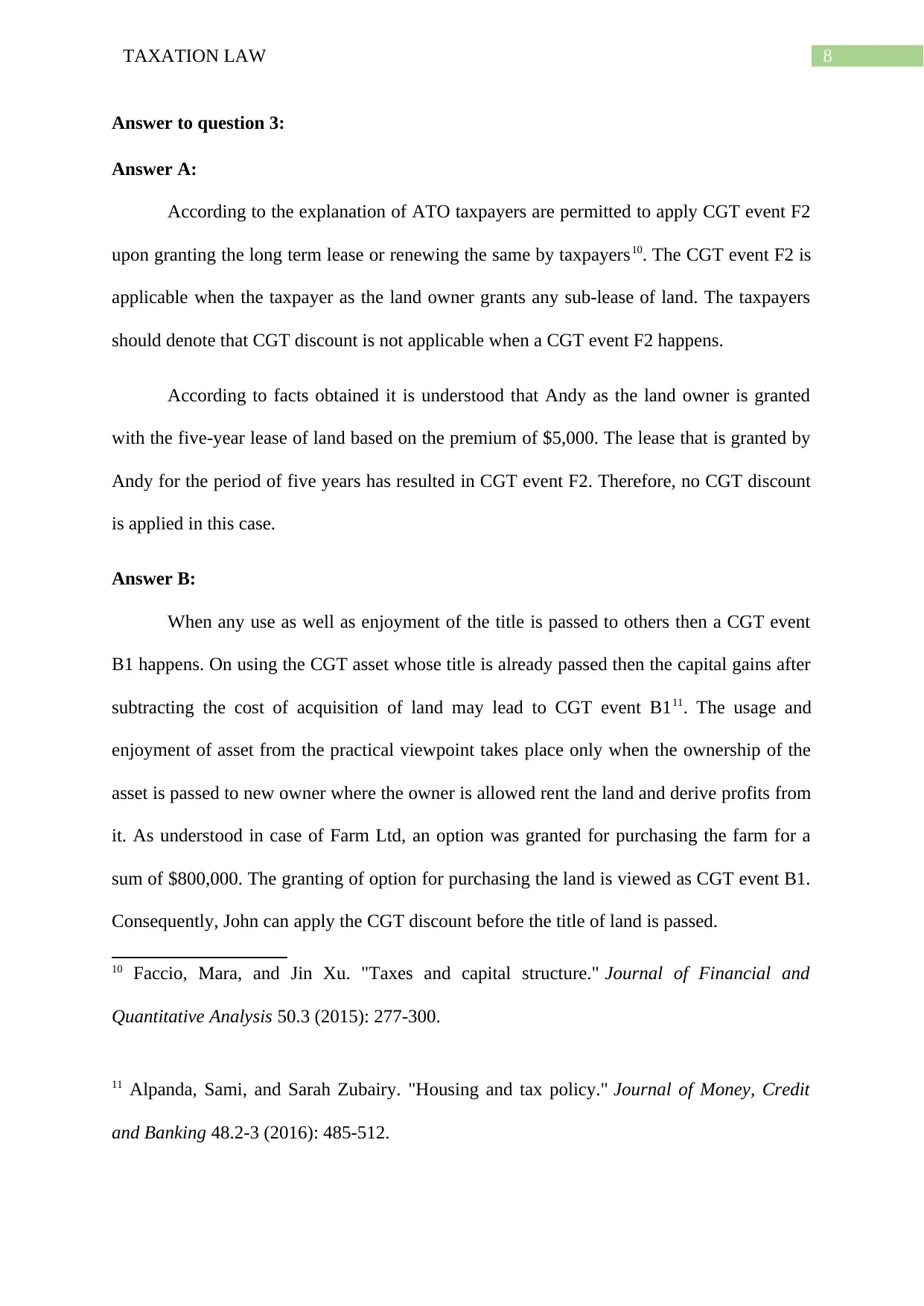
8TAXATION LAW
Answer to question 3:
Answer A:
According to the explanation of ATO taxpayers are permitted to apply CGT event F2
upon granting the long term lease or renewing the same by taxpayers10. The CGT event F2 is
applicable when the taxpayer as the land owner grants any sub-lease of land. The taxpayers
should denote that CGT discount is not applicable when a CGT event F2 happens.
According to facts obtained it is understood that Andy as the land owner is granted
with the five-year lease of land based on the premium of $5,000. The lease that is granted by
Andy for the period of five years has resulted in CGT event F2. Therefore, no CGT discount
is applied in this case.
Answer B:
When any use as well as enjoyment of the title is passed to others then a CGT event
B1 happens. On using the CGT asset whose title is already passed then the capital gains after
subtracting the cost of acquisition of land may lead to CGT event B111. The usage and
enjoyment of asset from the practical viewpoint takes place only when the ownership of the
asset is passed to new owner where the owner is allowed rent the land and derive profits from
it. As understood in case of Farm Ltd, an option was granted for purchasing the farm for a
sum of $800,000. The granting of option for purchasing the land is viewed as CGT event B1.
Consequently, John can apply the CGT discount before the title of land is passed.
10 Faccio, Mara, and Jin Xu. "Taxes and capital structure." Journal of Financial and
Quantitative Analysis 50.3 (2015): 277-300.
11 Alpanda, Sami, and Sarah Zubairy. "Housing and tax policy." Journal of Money, Credit
and Banking 48.2-3 (2016): 485-512.
Answer to question 3:
Answer A:
According to the explanation of ATO taxpayers are permitted to apply CGT event F2
upon granting the long term lease or renewing the same by taxpayers10. The CGT event F2 is
applicable when the taxpayer as the land owner grants any sub-lease of land. The taxpayers
should denote that CGT discount is not applicable when a CGT event F2 happens.
According to facts obtained it is understood that Andy as the land owner is granted
with the five-year lease of land based on the premium of $5,000. The lease that is granted by
Andy for the period of five years has resulted in CGT event F2. Therefore, no CGT discount
is applied in this case.
Answer B:
When any use as well as enjoyment of the title is passed to others then a CGT event
B1 happens. On using the CGT asset whose title is already passed then the capital gains after
subtracting the cost of acquisition of land may lead to CGT event B111. The usage and
enjoyment of asset from the practical viewpoint takes place only when the ownership of the
asset is passed to new owner where the owner is allowed rent the land and derive profits from
it. As understood in case of Farm Ltd, an option was granted for purchasing the farm for a
sum of $800,000. The granting of option for purchasing the land is viewed as CGT event B1.
Consequently, John can apply the CGT discount before the title of land is passed.
10 Faccio, Mara, and Jin Xu. "Taxes and capital structure." Journal of Financial and
Quantitative Analysis 50.3 (2015): 277-300.
11 Alpanda, Sami, and Sarah Zubairy. "Housing and tax policy." Journal of Money, Credit
and Banking 48.2-3 (2016): 485-512.

9TAXATION LAW
Answer C:
For capital gains tax purpose the main residence of tax payer is generally exempted.
However, full main residence is only applied when no part of the house is used for running
business. Where any portion of the house is used for deriving profits or running business then
a partial main residence exemption is provided for capital gains tax12.
Jamie and Olivia bought a property which they rented it out for two years. From 2008
onwards the property was used for dwelling purpose and eventually sold in 2018. Jamie and
Olivia can only be permitted to claim partial main residence exemption from capital gains
tax. Furthermore, they are eligible for 50% CGT discount upon the sale of house.
Answer D:
CGT discount is only allowed on capital gains where the asset is held for a 12 months or
more.
Particulars Amount (AUD$)Amount (AUD$)
Proceeds from the sale of BHP Shares (CGT Event A1 (section 104-
10(1)) 18,720.00$
Element 1: Cost of Acquisition (section 110-25(1)) 5,400.00$
Taxable Capital gains 13,320.00$
Proceeds from the sale of Wesfarmers Shares (CGT Event A1
(section 104-10(1)) 10,500.00$
Element 1: Cost of Acquisition (section 110-25(1)) 26,000.00$
Loss on Sale -15,500.00$
Net capital loss -2,180.00$
Calculation of Capital Gains Tax
In the Books of Chris
For the year ended 2019
Chris derived capital gains that amounted to $13,320 upon selling the BHP shares
while the disposal of Wesfarmers shares resulted in loss of $15,500. As the assets were not
12 Auerbach, Alan J., and Kevin Hassett. "Capital taxation in the twenty-first
century." American Economic Review 105.5 (2015): 38-42.
Answer C:
For capital gains tax purpose the main residence of tax payer is generally exempted.
However, full main residence is only applied when no part of the house is used for running
business. Where any portion of the house is used for deriving profits or running business then
a partial main residence exemption is provided for capital gains tax12.
Jamie and Olivia bought a property which they rented it out for two years. From 2008
onwards the property was used for dwelling purpose and eventually sold in 2018. Jamie and
Olivia can only be permitted to claim partial main residence exemption from capital gains
tax. Furthermore, they are eligible for 50% CGT discount upon the sale of house.
Answer D:
CGT discount is only allowed on capital gains where the asset is held for a 12 months or
more.
Particulars Amount (AUD$)Amount (AUD$)
Proceeds from the sale of BHP Shares (CGT Event A1 (section 104-
10(1)) 18,720.00$
Element 1: Cost of Acquisition (section 110-25(1)) 5,400.00$
Taxable Capital gains 13,320.00$
Proceeds from the sale of Wesfarmers Shares (CGT Event A1
(section 104-10(1)) 10,500.00$
Element 1: Cost of Acquisition (section 110-25(1)) 26,000.00$
Loss on Sale -15,500.00$
Net capital loss -2,180.00$
Calculation of Capital Gains Tax
In the Books of Chris
For the year ended 2019
Chris derived capital gains that amounted to $13,320 upon selling the BHP shares
while the disposal of Wesfarmers shares resulted in loss of $15,500. As the assets were not
12 Auerbach, Alan J., and Kevin Hassett. "Capital taxation in the twenty-first
century." American Economic Review 105.5 (2015): 38-42.
Secure Best Marks with AI Grader
Need help grading? Try our AI Grader for instant feedback on your assignments.
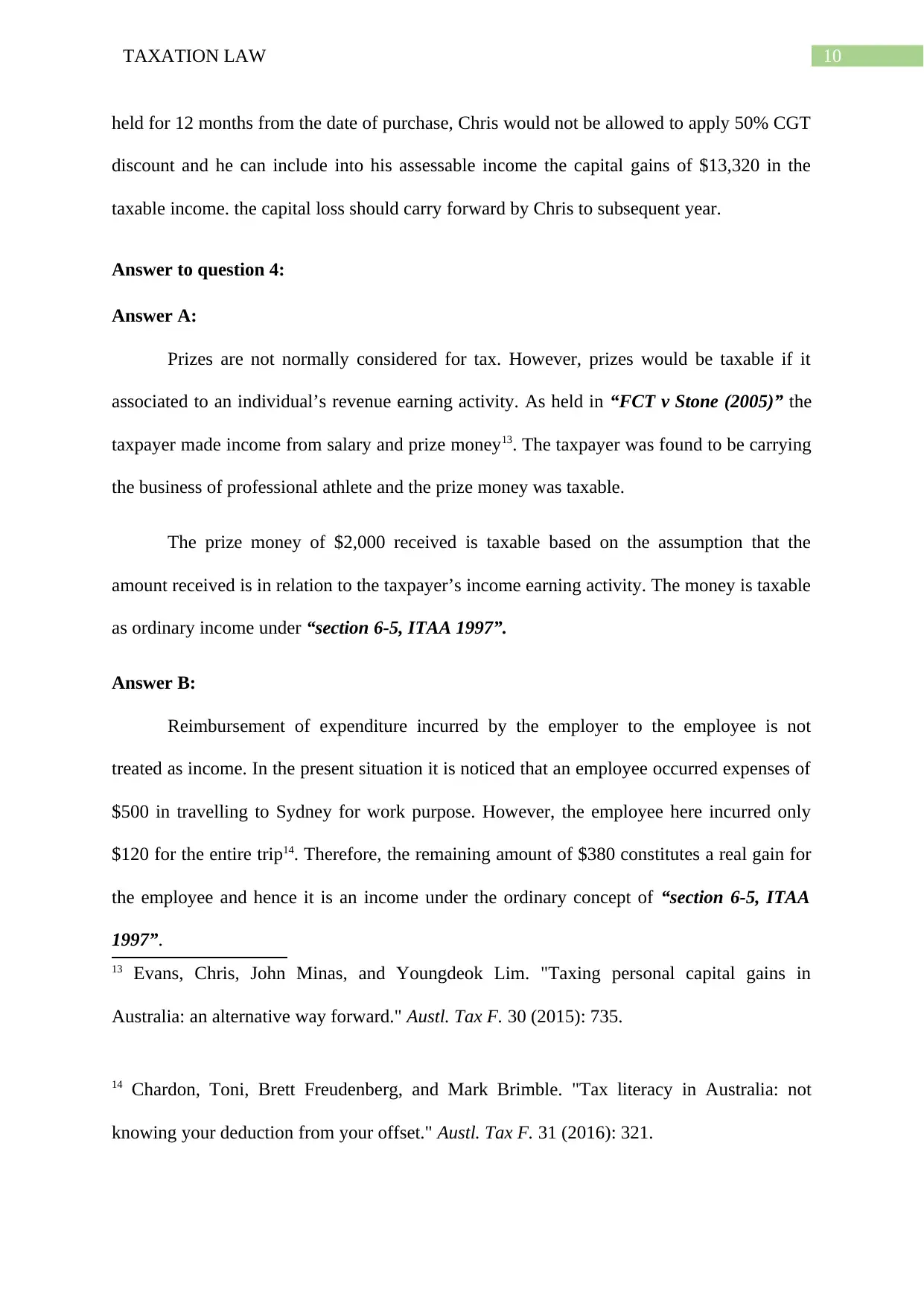
10TAXATION LAW
held for 12 months from the date of purchase, Chris would not be allowed to apply 50% CGT
discount and he can include into his assessable income the capital gains of $13,320 in the
taxable income. the capital loss should carry forward by Chris to subsequent year.
Answer to question 4:
Answer A:
Prizes are not normally considered for tax. However, prizes would be taxable if it
associated to an individual’s revenue earning activity. As held in “FCT v Stone (2005)” the
taxpayer made income from salary and prize money13. The taxpayer was found to be carrying
the business of professional athlete and the prize money was taxable.
The prize money of $2,000 received is taxable based on the assumption that the
amount received is in relation to the taxpayer’s income earning activity. The money is taxable
as ordinary income under “section 6-5, ITAA 1997”.
Answer B:
Reimbursement of expenditure incurred by the employer to the employee is not
treated as income. In the present situation it is noticed that an employee occurred expenses of
$500 in travelling to Sydney for work purpose. However, the employee here incurred only
$120 for the entire trip14. Therefore, the remaining amount of $380 constitutes a real gain for
the employee and hence it is an income under the ordinary concept of “section 6-5, ITAA
1997”.
13 Evans, Chris, John Minas, and Youngdeok Lim. "Taxing personal capital gains in
Australia: an alternative way forward." Austl. Tax F. 30 (2015): 735.
14 Chardon, Toni, Brett Freudenberg, and Mark Brimble. "Tax literacy in Australia: not
knowing your deduction from your offset." Austl. Tax F. 31 (2016): 321.
held for 12 months from the date of purchase, Chris would not be allowed to apply 50% CGT
discount and he can include into his assessable income the capital gains of $13,320 in the
taxable income. the capital loss should carry forward by Chris to subsequent year.
Answer to question 4:
Answer A:
Prizes are not normally considered for tax. However, prizes would be taxable if it
associated to an individual’s revenue earning activity. As held in “FCT v Stone (2005)” the
taxpayer made income from salary and prize money13. The taxpayer was found to be carrying
the business of professional athlete and the prize money was taxable.
The prize money of $2,000 received is taxable based on the assumption that the
amount received is in relation to the taxpayer’s income earning activity. The money is taxable
as ordinary income under “section 6-5, ITAA 1997”.
Answer B:
Reimbursement of expenditure incurred by the employer to the employee is not
treated as income. In the present situation it is noticed that an employee occurred expenses of
$500 in travelling to Sydney for work purpose. However, the employee here incurred only
$120 for the entire trip14. Therefore, the remaining amount of $380 constitutes a real gain for
the employee and hence it is an income under the ordinary concept of “section 6-5, ITAA
1997”.
13 Evans, Chris, John Minas, and Youngdeok Lim. "Taxing personal capital gains in
Australia: an alternative way forward." Austl. Tax F. 30 (2015): 735.
14 Chardon, Toni, Brett Freudenberg, and Mark Brimble. "Tax literacy in Australia: not
knowing your deduction from your offset." Austl. Tax F. 31 (2016): 321.

11TAXATION LAW
Answer C:
A gain that are treated as simple gifts normally does not possess any income
characteristics. As stated in “Scott v FCT (1966)” the solicitor was given a gift that amounted
to $10,000 from the clients wife out of the long estate of husband was not treated as income15.
In agreement with the above stated case it can be stated that the iphone of $1,000 received
from the client is not treated as having an income character.
Answer D:
In certain situations an individual may get lump sum payment that can be considered
taxable income. As it is explained in “paragraph 118-37 (1), (b), ITAA 1997” the taxpayers
should not include the receipts that are received as compensation payment for any kind of
personal injury suffered due to wrong or illness.
A taxpayer here is awarded with the amount of $10,000 as a result of personal injuries
suffered from the car accident. The amount under the “paragraph 118-37 (1), (b), ITAA
1997” should be excluded from assessment purpose because it is not an income.
Answer E:
There may be circumstances where the taxpayer may expect earning income in the
future period of time on the basis of currently being entitled to income in the upcoming year
is considered too remote to offer any form of connection with the present income year16. A
taxpayer purchases a share for $5 during the year and on 30th June, the taxpayer yet owns the
shares which is presently trending for $7.50. No income is earned in this situation because the
15 Woellner, Robin, et al. "Australian Taxation Law 2016." OUP Catalogue (2016).
16 Barkoczy, Stephen. "Foundations of taxation law 2016." OUP Catalogue (2016).
Answer C:
A gain that are treated as simple gifts normally does not possess any income
characteristics. As stated in “Scott v FCT (1966)” the solicitor was given a gift that amounted
to $10,000 from the clients wife out of the long estate of husband was not treated as income15.
In agreement with the above stated case it can be stated that the iphone of $1,000 received
from the client is not treated as having an income character.
Answer D:
In certain situations an individual may get lump sum payment that can be considered
taxable income. As it is explained in “paragraph 118-37 (1), (b), ITAA 1997” the taxpayers
should not include the receipts that are received as compensation payment for any kind of
personal injury suffered due to wrong or illness.
A taxpayer here is awarded with the amount of $10,000 as a result of personal injuries
suffered from the car accident. The amount under the “paragraph 118-37 (1), (b), ITAA
1997” should be excluded from assessment purpose because it is not an income.
Answer E:
There may be circumstances where the taxpayer may expect earning income in the
future period of time on the basis of currently being entitled to income in the upcoming year
is considered too remote to offer any form of connection with the present income year16. A
taxpayer purchases a share for $5 during the year and on 30th June, the taxpayer yet owns the
shares which is presently trending for $7.50. No income is earned in this situation because the
15 Woellner, Robin, et al. "Australian Taxation Law 2016." OUP Catalogue (2016).
16 Barkoczy, Stephen. "Foundations of taxation law 2016." OUP Catalogue (2016).
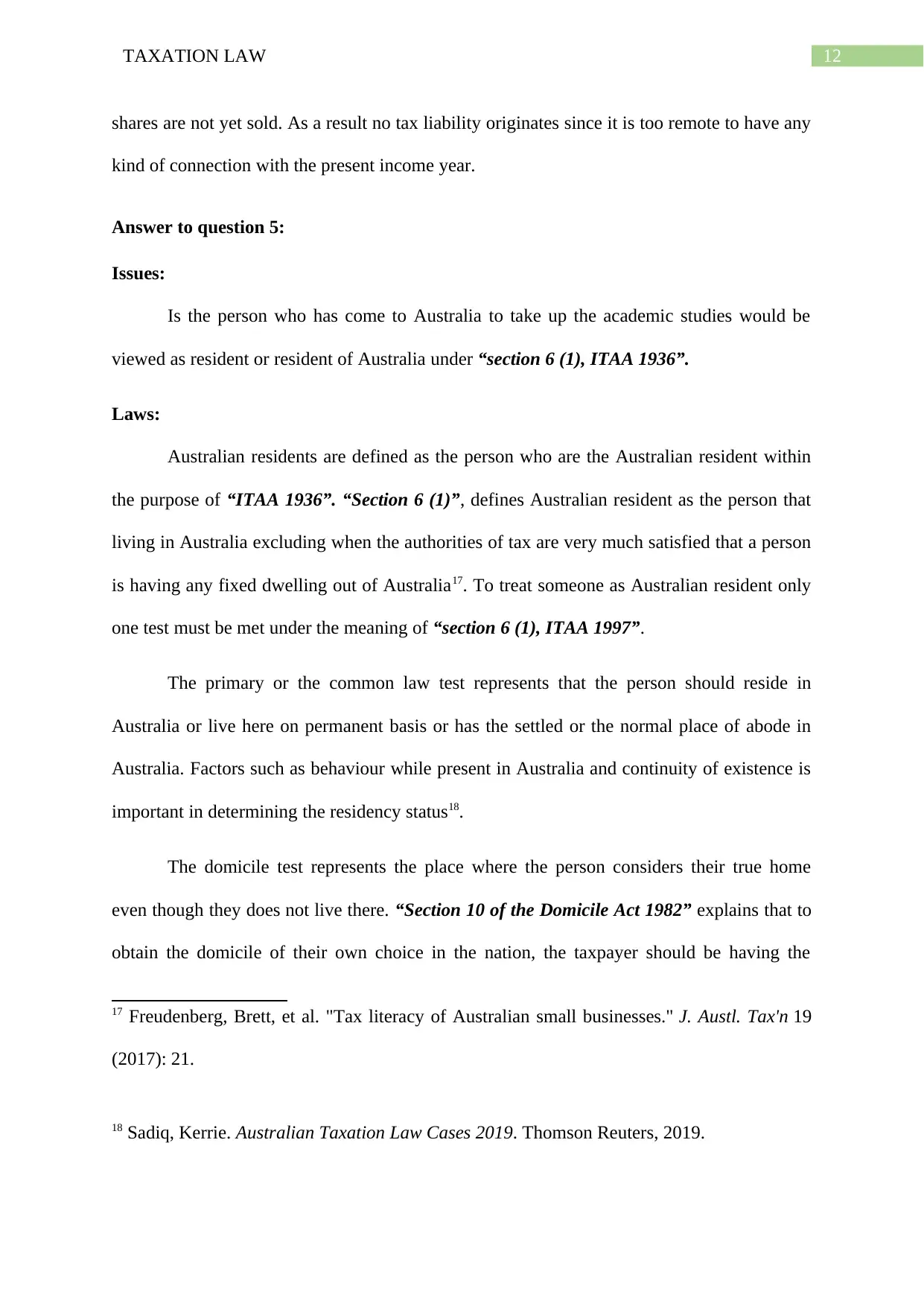
12TAXATION LAW
shares are not yet sold. As a result no tax liability originates since it is too remote to have any
kind of connection with the present income year.
Answer to question 5:
Issues:
Is the person who has come to Australia to take up the academic studies would be
viewed as resident or resident of Australia under “section 6 (1), ITAA 1936”.
Laws:
Australian residents are defined as the person who are the Australian resident within
the purpose of “ITAA 1936”. “Section 6 (1)”, defines Australian resident as the person that
living in Australia excluding when the authorities of tax are very much satisfied that a person
is having any fixed dwelling out of Australia17. To treat someone as Australian resident only
one test must be met under the meaning of “section 6 (1), ITAA 1997”.
The primary or the common law test represents that the person should reside in
Australia or live here on permanent basis or has the settled or the normal place of abode in
Australia. Factors such as behaviour while present in Australia and continuity of existence is
important in determining the residency status18.
The domicile test represents the place where the person considers their true home
even though they does not live there. “Section 10 of the Domicile Act 1982” explains that to
obtain the domicile of their own choice in the nation, the taxpayer should be having the
17 Freudenberg, Brett, et al. "Tax literacy of Australian small businesses." J. Austl. Tax'n 19
(2017): 21.
18 Sadiq, Kerrie. Australian Taxation Law Cases 2019. Thomson Reuters, 2019.
shares are not yet sold. As a result no tax liability originates since it is too remote to have any
kind of connection with the present income year.
Answer to question 5:
Issues:
Is the person who has come to Australia to take up the academic studies would be
viewed as resident or resident of Australia under “section 6 (1), ITAA 1936”.
Laws:
Australian residents are defined as the person who are the Australian resident within
the purpose of “ITAA 1936”. “Section 6 (1)”, defines Australian resident as the person that
living in Australia excluding when the authorities of tax are very much satisfied that a person
is having any fixed dwelling out of Australia17. To treat someone as Australian resident only
one test must be met under the meaning of “section 6 (1), ITAA 1997”.
The primary or the common law test represents that the person should reside in
Australia or live here on permanent basis or has the settled or the normal place of abode in
Australia. Factors such as behaviour while present in Australia and continuity of existence is
important in determining the residency status18.
The domicile test represents the place where the person considers their true home
even though they does not live there. “Section 10 of the Domicile Act 1982” explains that to
obtain the domicile of their own choice in the nation, the taxpayer should be having the
17 Freudenberg, Brett, et al. "Tax literacy of Australian small businesses." J. Austl. Tax'n 19
(2017): 21.
18 Sadiq, Kerrie. Australian Taxation Law Cases 2019. Thomson Reuters, 2019.
Paraphrase This Document
Need a fresh take? Get an instant paraphrase of this document with our AI Paraphraser
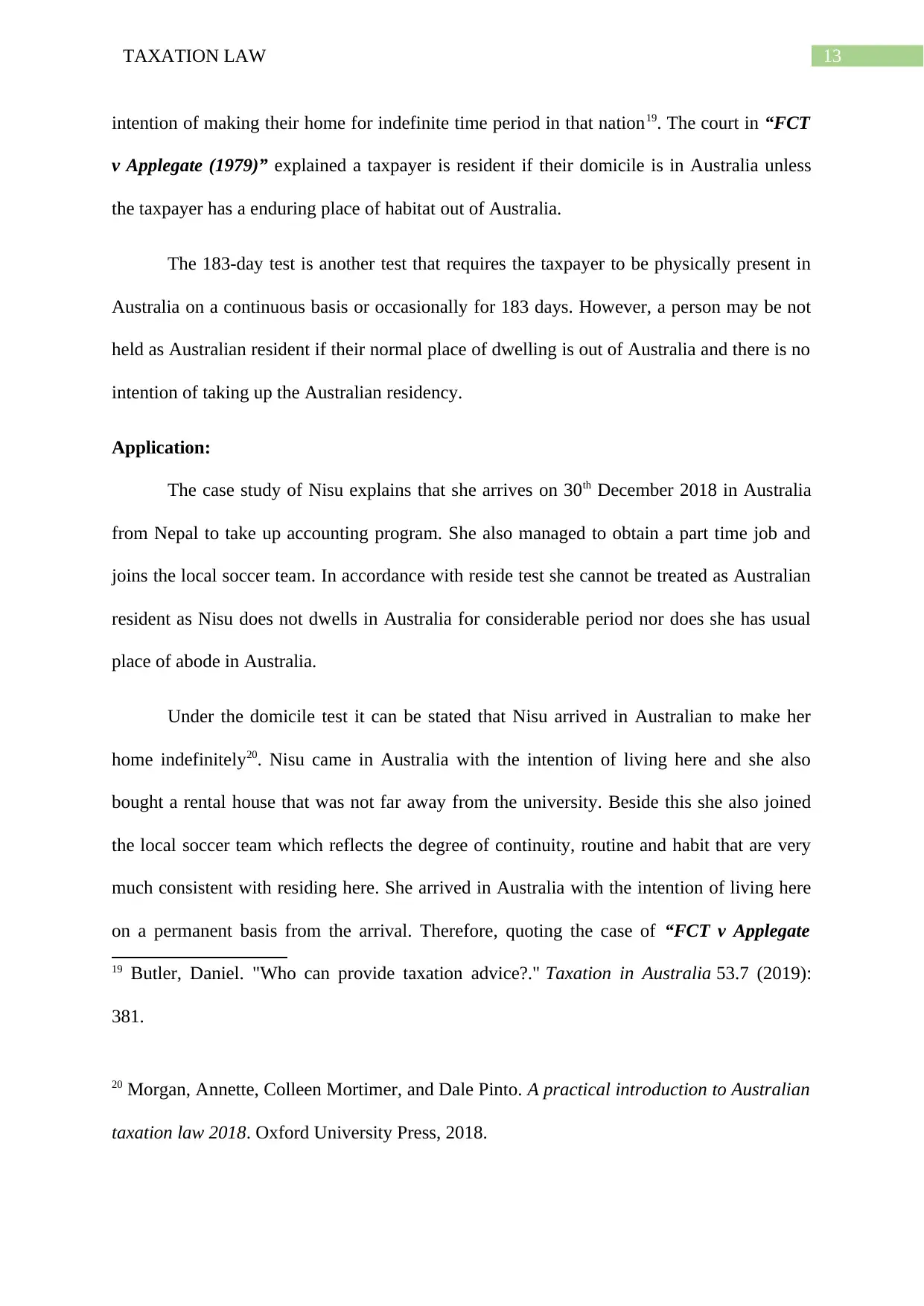
13TAXATION LAW
intention of making their home for indefinite time period in that nation19. The court in “FCT
v Applegate (1979)” explained a taxpayer is resident if their domicile is in Australia unless
the taxpayer has a enduring place of habitat out of Australia.
The 183-day test is another test that requires the taxpayer to be physically present in
Australia on a continuous basis or occasionally for 183 days. However, a person may be not
held as Australian resident if their normal place of dwelling is out of Australia and there is no
intention of taking up the Australian residency.
Application:
The case study of Nisu explains that she arrives on 30th December 2018 in Australia
from Nepal to take up accounting program. She also managed to obtain a part time job and
joins the local soccer team. In accordance with reside test she cannot be treated as Australian
resident as Nisu does not dwells in Australia for considerable period nor does she has usual
place of abode in Australia.
Under the domicile test it can be stated that Nisu arrived in Australian to make her
home indefinitely20. Nisu came in Australia with the intention of living here and she also
bought a rental house that was not far away from the university. Beside this she also joined
the local soccer team which reflects the degree of continuity, routine and habit that are very
much consistent with residing here. She arrived in Australia with the intention of living here
on a permanent basis from the arrival. Therefore, quoting the case of “FCT v Applegate
19 Butler, Daniel. "Who can provide taxation advice?." Taxation in Australia 53.7 (2019):
381.
20 Morgan, Annette, Colleen Mortimer, and Dale Pinto. A practical introduction to Australian
taxation law 2018. Oxford University Press, 2018.
intention of making their home for indefinite time period in that nation19. The court in “FCT
v Applegate (1979)” explained a taxpayer is resident if their domicile is in Australia unless
the taxpayer has a enduring place of habitat out of Australia.
The 183-day test is another test that requires the taxpayer to be physically present in
Australia on a continuous basis or occasionally for 183 days. However, a person may be not
held as Australian resident if their normal place of dwelling is out of Australia and there is no
intention of taking up the Australian residency.
Application:
The case study of Nisu explains that she arrives on 30th December 2018 in Australia
from Nepal to take up accounting program. She also managed to obtain a part time job and
joins the local soccer team. In accordance with reside test she cannot be treated as Australian
resident as Nisu does not dwells in Australia for considerable period nor does she has usual
place of abode in Australia.
Under the domicile test it can be stated that Nisu arrived in Australian to make her
home indefinitely20. Nisu came in Australia with the intention of living here and she also
bought a rental house that was not far away from the university. Beside this she also joined
the local soccer team which reflects the degree of continuity, routine and habit that are very
much consistent with residing here. She arrived in Australia with the intention of living here
on a permanent basis from the arrival. Therefore, quoting the case of “FCT v Applegate
19 Butler, Daniel. "Who can provide taxation advice?." Taxation in Australia 53.7 (2019):
381.
20 Morgan, Annette, Colleen Mortimer, and Dale Pinto. A practical introduction to Australian
taxation law 2018. Oxford University Press, 2018.

14TAXATION LAW
(1979)” it can be stated that she has acquired the Australian domicile. Nisu is an Australian
resident under the domicile test21.
Under the 183 day test it can be stated that ever since 30th December 2018 to 30th June
2019 Nisu has been continuously present in Australia for 183 days. Therefore, Nisu also
meets the criteria of 183 day test to be held as Australian resident within the meaning of
“section 6 (1), ITAA 1936”.
Conclusion:
Nisu has satisified the domicile test and the 183-day test because she was present in
Australia for 183 days and her behaviour reflects the degree of continuity, routine and habit
that are very much consistent with residing here. She is an Australian resident under “section
6 (1), ITAA 1997”.
21 Cavenagh, Jennifer, et al. "Australian legislation concerning matters of international law
2016." Australian Year Book of International Law 35 (2018): 353.
(1979)” it can be stated that she has acquired the Australian domicile. Nisu is an Australian
resident under the domicile test21.
Under the 183 day test it can be stated that ever since 30th December 2018 to 30th June
2019 Nisu has been continuously present in Australia for 183 days. Therefore, Nisu also
meets the criteria of 183 day test to be held as Australian resident within the meaning of
“section 6 (1), ITAA 1936”.
Conclusion:
Nisu has satisified the domicile test and the 183-day test because she was present in
Australia for 183 days and her behaviour reflects the degree of continuity, routine and habit
that are very much consistent with residing here. She is an Australian resident under “section
6 (1), ITAA 1997”.
21 Cavenagh, Jennifer, et al. "Australian legislation concerning matters of international law
2016." Australian Year Book of International Law 35 (2018): 353.
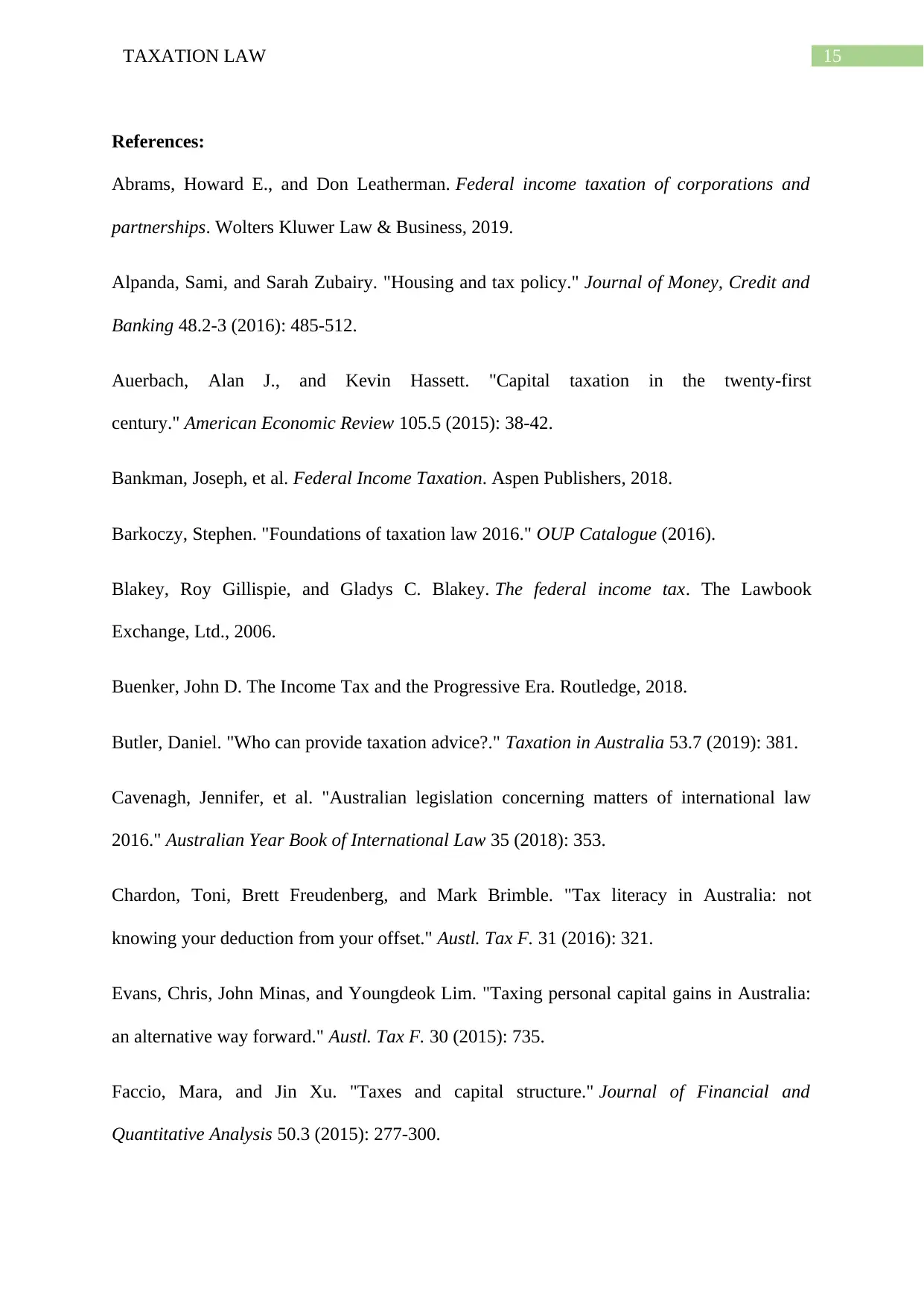
15TAXATION LAW
References:
Abrams, Howard E., and Don Leatherman. Federal income taxation of corporations and
partnerships. Wolters Kluwer Law & Business, 2019.
Alpanda, Sami, and Sarah Zubairy. "Housing and tax policy." Journal of Money, Credit and
Banking 48.2-3 (2016): 485-512.
Auerbach, Alan J., and Kevin Hassett. "Capital taxation in the twenty-first
century." American Economic Review 105.5 (2015): 38-42.
Bankman, Joseph, et al. Federal Income Taxation. Aspen Publishers, 2018.
Barkoczy, Stephen. "Foundations of taxation law 2016." OUP Catalogue (2016).
Blakey, Roy Gillispie, and Gladys C. Blakey. The federal income tax. The Lawbook
Exchange, Ltd., 2006.
Buenker, John D. The Income Tax and the Progressive Era. Routledge, 2018.
Butler, Daniel. "Who can provide taxation advice?." Taxation in Australia 53.7 (2019): 381.
Cavenagh, Jennifer, et al. "Australian legislation concerning matters of international law
2016." Australian Year Book of International Law 35 (2018): 353.
Chardon, Toni, Brett Freudenberg, and Mark Brimble. "Tax literacy in Australia: not
knowing your deduction from your offset." Austl. Tax F. 31 (2016): 321.
Evans, Chris, John Minas, and Youngdeok Lim. "Taxing personal capital gains in Australia:
an alternative way forward." Austl. Tax F. 30 (2015): 735.
Faccio, Mara, and Jin Xu. "Taxes and capital structure." Journal of Financial and
Quantitative Analysis 50.3 (2015): 277-300.
References:
Abrams, Howard E., and Don Leatherman. Federal income taxation of corporations and
partnerships. Wolters Kluwer Law & Business, 2019.
Alpanda, Sami, and Sarah Zubairy. "Housing and tax policy." Journal of Money, Credit and
Banking 48.2-3 (2016): 485-512.
Auerbach, Alan J., and Kevin Hassett. "Capital taxation in the twenty-first
century." American Economic Review 105.5 (2015): 38-42.
Bankman, Joseph, et al. Federal Income Taxation. Aspen Publishers, 2018.
Barkoczy, Stephen. "Foundations of taxation law 2016." OUP Catalogue (2016).
Blakey, Roy Gillispie, and Gladys C. Blakey. The federal income tax. The Lawbook
Exchange, Ltd., 2006.
Buenker, John D. The Income Tax and the Progressive Era. Routledge, 2018.
Butler, Daniel. "Who can provide taxation advice?." Taxation in Australia 53.7 (2019): 381.
Cavenagh, Jennifer, et al. "Australian legislation concerning matters of international law
2016." Australian Year Book of International Law 35 (2018): 353.
Chardon, Toni, Brett Freudenberg, and Mark Brimble. "Tax literacy in Australia: not
knowing your deduction from your offset." Austl. Tax F. 31 (2016): 321.
Evans, Chris, John Minas, and Youngdeok Lim. "Taxing personal capital gains in Australia:
an alternative way forward." Austl. Tax F. 30 (2015): 735.
Faccio, Mara, and Jin Xu. "Taxes and capital structure." Journal of Financial and
Quantitative Analysis 50.3 (2015): 277-300.
Secure Best Marks with AI Grader
Need help grading? Try our AI Grader for instant feedback on your assignments.
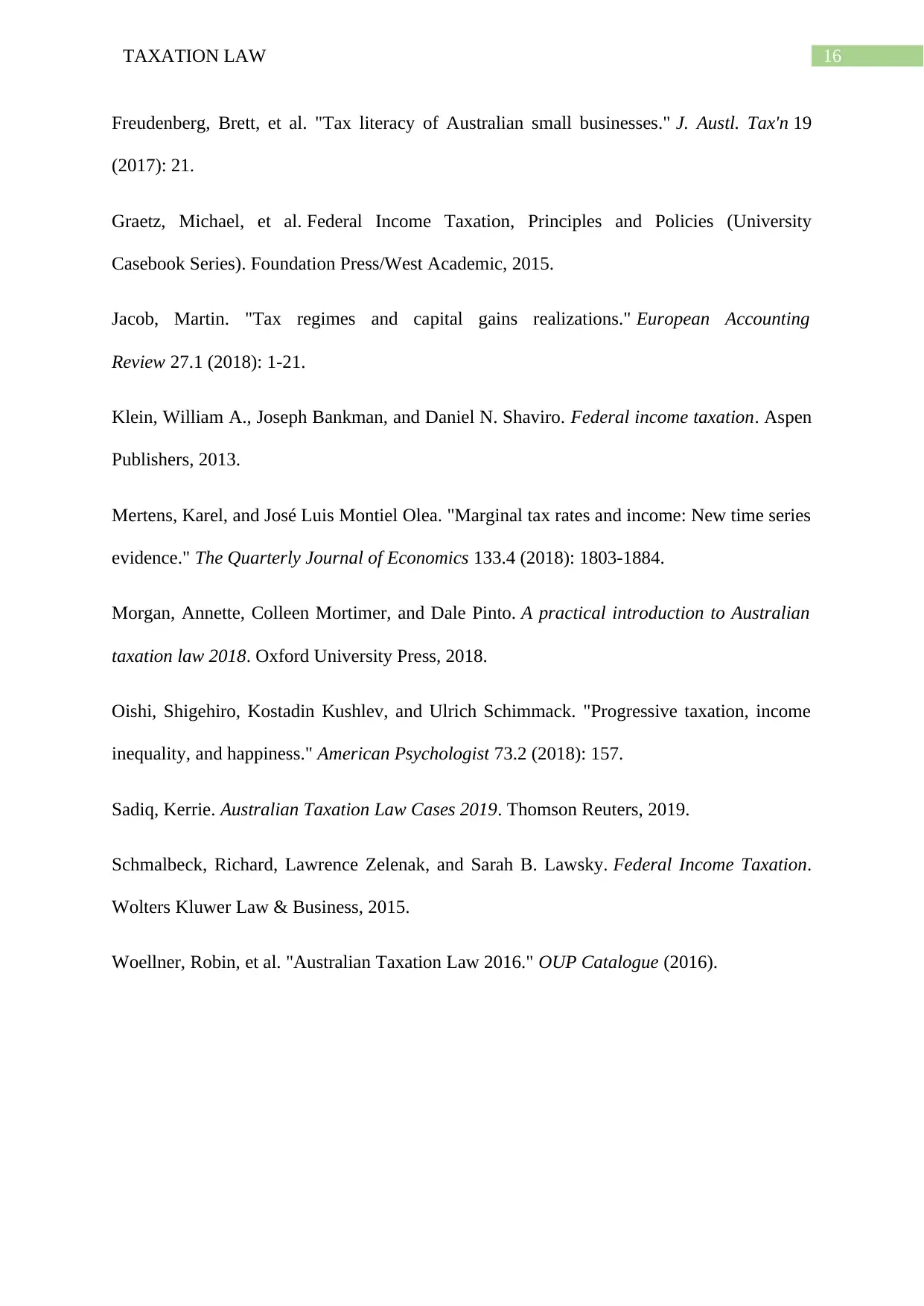
16TAXATION LAW
Freudenberg, Brett, et al. "Tax literacy of Australian small businesses." J. Austl. Tax'n 19
(2017): 21.
Graetz, Michael, et al. Federal Income Taxation, Principles and Policies (University
Casebook Series). Foundation Press/West Academic, 2015.
Jacob, Martin. "Tax regimes and capital gains realizations." European Accounting
Review 27.1 (2018): 1-21.
Klein, William A., Joseph Bankman, and Daniel N. Shaviro. Federal income taxation. Aspen
Publishers, 2013.
Mertens, Karel, and José Luis Montiel Olea. "Marginal tax rates and income: New time series
evidence." The Quarterly Journal of Economics 133.4 (2018): 1803-1884.
Morgan, Annette, Colleen Mortimer, and Dale Pinto. A practical introduction to Australian
taxation law 2018. Oxford University Press, 2018.
Oishi, Shigehiro, Kostadin Kushlev, and Ulrich Schimmack. "Progressive taxation, income
inequality, and happiness." American Psychologist 73.2 (2018): 157.
Sadiq, Kerrie. Australian Taxation Law Cases 2019. Thomson Reuters, 2019.
Schmalbeck, Richard, Lawrence Zelenak, and Sarah B. Lawsky. Federal Income Taxation.
Wolters Kluwer Law & Business, 2015.
Woellner, Robin, et al. "Australian Taxation Law 2016." OUP Catalogue (2016).
Freudenberg, Brett, et al. "Tax literacy of Australian small businesses." J. Austl. Tax'n 19
(2017): 21.
Graetz, Michael, et al. Federal Income Taxation, Principles and Policies (University
Casebook Series). Foundation Press/West Academic, 2015.
Jacob, Martin. "Tax regimes and capital gains realizations." European Accounting
Review 27.1 (2018): 1-21.
Klein, William A., Joseph Bankman, and Daniel N. Shaviro. Federal income taxation. Aspen
Publishers, 2013.
Mertens, Karel, and José Luis Montiel Olea. "Marginal tax rates and income: New time series
evidence." The Quarterly Journal of Economics 133.4 (2018): 1803-1884.
Morgan, Annette, Colleen Mortimer, and Dale Pinto. A practical introduction to Australian
taxation law 2018. Oxford University Press, 2018.
Oishi, Shigehiro, Kostadin Kushlev, and Ulrich Schimmack. "Progressive taxation, income
inequality, and happiness." American Psychologist 73.2 (2018): 157.
Sadiq, Kerrie. Australian Taxation Law Cases 2019. Thomson Reuters, 2019.
Schmalbeck, Richard, Lawrence Zelenak, and Sarah B. Lawsky. Federal Income Taxation.
Wolters Kluwer Law & Business, 2015.
Woellner, Robin, et al. "Australian Taxation Law 2016." OUP Catalogue (2016).
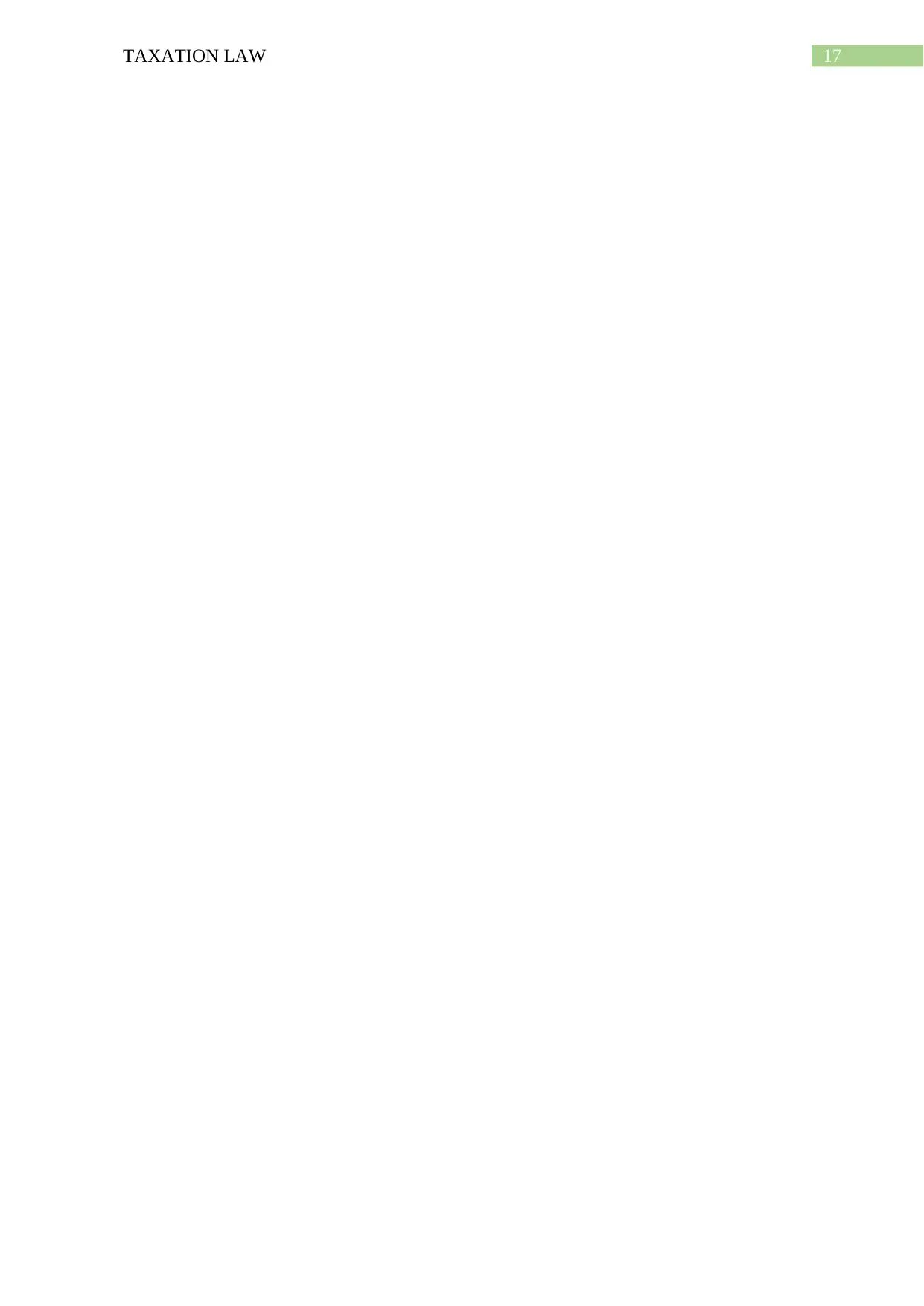
17TAXATION LAW
1 out of 18
Your All-in-One AI-Powered Toolkit for Academic Success.
+13062052269
info@desklib.com
Available 24*7 on WhatsApp / Email
![[object Object]](/_next/static/media/star-bottom.7253800d.svg)
Unlock your academic potential
© 2024 | Zucol Services PVT LTD | All rights reserved.





